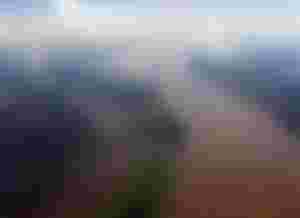
The vast Amazon basin (Amazonia), the largest lowland in Latin America, has an area of about 2.7 million square miles (7 million square km) and is nearly twice as large as that of the Congo River, the Earth’s other great equatorial drainage system. Stretching some 1,725 miles (2,780 km) from north to south at its widest point, the basin includes the greater part of Brazil and Peru, significant parts of Colombia, Ecuador, and Bolivia, and a small area of Venezuela; roughly two-thirds of the Amazon’s main stream and by far the largest portion of its basin are within Brazil. The Tocantins-Araguaia catchment area in Pará state covers another 300,000 square miles (777,000 square km). Although considered a part of Amazonia by the Brazilian government and in popular usage, it is technically a separate system. It is estimated that about one-fifth of all the water that runs off Earth’s surface is carried by the Amazon. The flood-stage discharge at the river’s mouth is four times that of the Congo and more than 10 times the amount carried by the Mississippi River. This immense volume of fresh water dilutes the ocean’s saltiness for more than 100 miles (160 km) from shore.

The Central and Northern Andes and the Amazon River basin and drainage network.Encyclopædia Britannica, Inc.
The extensive lowland areas bordering the main river and its tributaries, called várzeas (“floodplains”), are subject to annual flooding, with consequent soil enrichment; however, most of the vast basin consists of upland, well above the inundations and known as terra firme. More than two-thirds of the basin is covered by an immense rainforest, which grades into dry forest and savanna on the higher northern and southern margins and into montane forest in the Andes to the west. The Amazon Rainforest, which represents about half of the Earth’s remaining rainforest, also constitutes its single largest reserve of biological resources.


I've been so familiar with Mississippi, never knew Amazon was a river